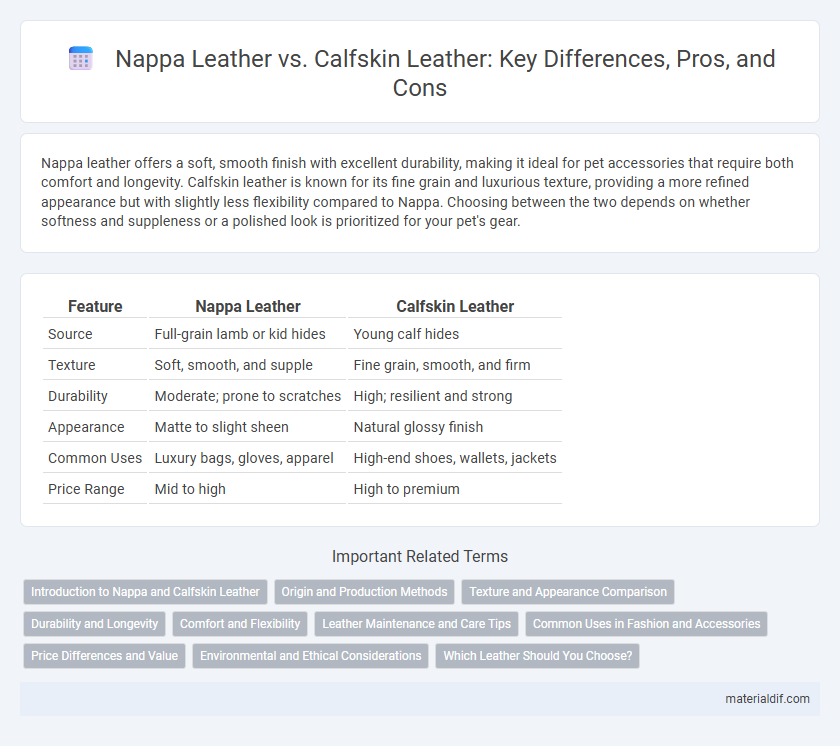Nappa leather offers a soft, smooth finish with excellent durability, making it ideal for pet accessories that require both comfort and longevity. Calfskin leather is known for its fine grain and luxurious texture, providing a more refined appearance but with slightly less flexibility compared to Nappa. Choosing between the two depends on whether softness and suppleness or a polished look is prioritized for your pet's gear.
Table of Comparison
| Feature | Nappa Leather | Calfskin Leather |
|---|---|---|
| Source | Full-grain lamb or kid hides | Young calf hides |
| Texture | Soft, smooth, and supple | Fine grain, smooth, and firm |
| Durability | Moderate; prone to scratches | High; resilient and strong |
| Appearance | Matte to slight sheen | Natural glossy finish |
| Common Uses | Luxury bags, gloves, apparel | High-end shoes, wallets, jackets |
| Price Range | Mid to high | High to premium |
Introduction to Nappa and Calfskin Leather
Nappa leather is a premium, soft, and supple leather made from fully tanned lamb or goat hides, prized for its smooth texture and durability. Calfskin leather, derived from young cattle, offers a fine grain and luxurious feel with excellent strength and resistance to wear. Both types are highly valued in luxury goods, with Nappa leather favored for its softness and Calfskin for its refined appearance and longevity.
Origin and Production Methods
Nappa leather originates from unsplit, full-grain skins of lamb, goat, or calf, primarily produced through a special tanning process that uses chrome salts to achieve its renowned softness and smooth texture. Calfskin leather, sourced specifically from young cattle, undergoes a vegetable tanning or chrome tanning method that preserves its fine grain and durability while offering a slightly firmer feel compared to Nappa. Both types are prized for high-quality leather goods, but their distinct origins and tanning techniques influence their texture, strength, and overall performance in luxury products.
Texture and Appearance Comparison
Nappa leather is renowned for its smooth, supple texture and vibrant appearance, achieved through a full-grain, aniline tanning process that maintains natural markings and a soft hand feel. In contrast, calfskin leather features a firmer surface with a fine grain, offering a polished, uniform look often enhanced by a protective coating for increased durability and sheen. The distinct textures result in Nappa leather exuding a luxurious softness, while calfskin leather provides a refined elegance with greater structural integrity.
Durability and Longevity
Nappa leather, known for its smooth and supple texture, offers moderate durability but requires regular care to maintain its appearance and prevent wear. Calfskin leather, prized for its fine grain and strength, provides superior longevity and resistance to scratches, making it ideal for products subjected to frequent use. Both leathers age beautifully, but calfskin's denser fiber structure ensures enhanced durability over time compared to nappa leather.
Comfort and Flexibility
Nappa leather is renowned for its exceptional softness and pliability, offering superior comfort and flexibility compared to calfskin leather. While calfskin is durable and smooth, it tends to be firmer and less supple, making Nappa leather the preferred choice for applications where comfort and ease of movement are paramount. The fine grain and full aniline finish of Nappa leather enhance breathability and adaptability, contributing to long-lasting wearability.
Leather Maintenance and Care Tips
Nappa leather requires gentle cleaning with a damp cloth and conditioning every 3-6 months to maintain its softness and prevent cracking, while calfskin leather benefits from regular dusting and use of pH-balanced leather conditioners to preserve its smooth texture and durability. Both types should be kept away from direct sunlight and moisture to avoid fading and mold growth. Proper storage in breathable bags and avoiding excessive bending help extend the lifespan of Nappa and calfskin leather products.
Common Uses in Fashion and Accessories
Nappa leather, prized for its softness and supple texture, is widely used in luxury fashion items such as handbags, gloves, and high-end jackets, offering a smooth and refined finish. Calfskin leather, known for its durability and fine grain, is commonly chosen for premium shoes, wallets, and belts, delivering a polished look with long-lasting wear. Both leathers are favored in accessories for their quality, but Nappa excels in products requiring flexibility, while Calfskin is preferred for structured fashion pieces.
Price Differences and Value
Nappa leather typically commands a higher price than calfskin leather due to its superior softness, durability, and luxurious feel. Calfskin leather, while more affordable, offers good strength and a smooth texture, making it a cost-effective choice without sacrificing quality. Consumers seeking long-term value often prefer Nappa for its premium qualities despite the higher upfront cost.
Environmental and Ethical Considerations
Nappa leather, known for its soft texture and durability, often involves chemical-intensive tanning processes that can negatively impact ecosystems if not managed responsibly. Calfskin leather, sourced from young cattle, raises ethical questions related to animal welfare due to the use of juvenile animals and typically demands higher resource inputs for production. Sustainable practices and certifications such as vegetable tanning and traceability standards are critical in mitigating environmental damage and promoting ethical sourcing for both Nappa and Calfskin leather products.
Which Leather Should You Choose?
Nappa leather offers a soft, buttery texture with excellent breathability, making it ideal for luxury upholstery and clothing that require comfort and durability. Calfskin leather provides a denser, more durable surface with a smooth finish, favored for high-end footwear and accessories due to its longevity and refined appearance. Choose Nappa leather for supple, flexible products, while Calfskin leather suits applications needing robustness and a polished look.
Nappa Leather vs Calfskin Leather Infographic

 materialdif.com
materialdif.com